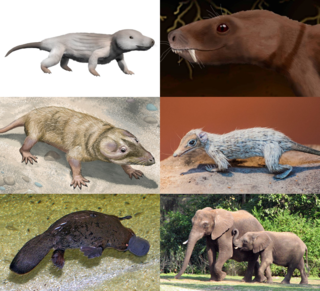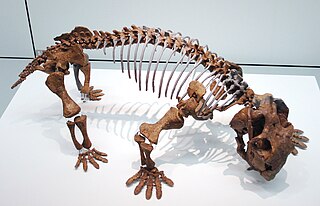The Permian is a geologic period and stratigraphic system which spans 47 million years from the end of the Carboniferous Period 298.9 million years ago (Mya), to the beginning of the Triassic Period 251.902 Mya. It is the last period of the Paleozoic Era; the following Triassic Period belongs to the Mesozoic Era. The concept of the Permian was introduced in 1841 by geologist Sir Roderick Murchison, who named it after the region of Perm in Russia.

The Permian–Triassic (P–T, P–Tr) extinction event (PTME), also known as the Late Permian extinction event, the Latest Permian extinction event, the End-Permian extinction event, and colloquially as the Great Dying, forms the boundary between the Permian and Triassic geologic periods, and with them the Paleozoic and Mesozoic eras respectively, approximately 251.9 million years ago. As the largest of the "Big Five" mass extinctions of the Phanerozoic, it is the Earth's most severe known extinction event, with the extinction of 57% of biological families, 83% of genera, 81% of marine species and 70% of terrestrial vertebrate species. It is also the largest known mass extinction of insects. There is evidence for one to three distinct pulses, or phases, of extinction.
The Triassic is a geologic period and system which spans 50.5 million years from the end of the Permian Period 251.902 million years ago (Mya), to the beginning of the Jurassic Period 201.4 Mya. The Triassic is the first and shortest period of the Mesozoic Era. Both the start and end of the period are marked by major extinction events. The Triassic Period is subdivided into three epochs: Early Triassic, Middle Triassic and Late Triassic.

Therapsida is a major group of eupelycosaurian synapsids that includes mammals, their ancestors and relatives. Many of the traits today seen as unique to mammals had their origin within early therapsids, including limbs that were oriented more underneath the body, as opposed to the sprawling posture of many reptiles and salamanders.

Cynodonts are eutheriodont therapsids belonging to the clade Cynodontia that first appeared in the Late Permian, and extensively diversified after the Permian–Triassic extinction event. Cynodonts occupied a variety of ecological niches, both as carnivores and as herbivores. Mammals are cynodonts, as are their extinct ancestors and close relatives, having evolved from advanced probainognathian cynodonts during the Late Triassic. All other cynodont lines went extinct, with the last known non-mammalian cynodont group, the Tritylodontidae, having its youngest records in the Early Cretaceous.

Ichthyopterygia was a designation introduced by Sir Richard Owen in 1840 to designate the Jurassic ichthyosaurs that were known at the time, but the term is now used more often for both true Ichthyosauria and their more primitive early and middle Triassic ancestors.

Anomodontia is an extinct group of non-mammalian therapsids from the Permian and Triassic periods. By far the most speciose group are the dicynodonts, a clade of beaked, tusked herbivores. Anomodonts were very diverse during the Middle Permian, including primitive forms like Anomocephalus and Patranomodon and groups like Venyukovioidea and Dromasauria. Dicynodonts became the most successful and abundant of all herbivores in the Late Permian, filling ecological niches ranging from large browsers down to small burrowers. Few dicynodont families survived the Permian–Triassic extinction event, but one lineage (Kannemeyeriiformes) evolved into large, stocky forms that became dominant terrestrial herbivores right until the Late Triassic, when changing conditions caused them to decline, finally going extinct during the Triassic–Jurassic extinction event.

Lystrosaurus is an extinct genus of herbivorous dicynodont therapsids from the late Permian and Early Triassic epochs. It lived in what is now Antarctica, India, China, Mongolia, European Russia and South Africa. Four to six species are currently recognized, although from the 1930s to 1970s the number of species was thought to be much higher. They ranged in size from that of a small dog to 8 feet long.
In the geologic time scale, the Changhsingian or Changxingian is the latest age or uppermost stage of the Permian. It is also the upper or latest of two subdivisions of the Lopingian Epoch or Series. The Changhsingian lasted from 254.14 to 251.9 million years ago (Ma). It was preceded by the Wuchiapingian and followed by the Induan.

The Early Triassic is the first of three epochs of the Triassic Period of the geologic timescale. It spans the time between 251.9 Ma and 247.2 Ma. Rocks from this epoch are collectively known as the Lower Triassic Series, which is a unit in chronostratigraphy.

In the geologic timescale, the Middle Triassic is the second of three epochs of the Triassic period or the middle of three series in which the Triassic system is divided in chronostratigraphy. The Middle Triassic spans the time between 247.2 Ma and 237 Ma. It is preceded by the Early Triassic Epoch and followed by the Late Triassic Epoch. The Middle Triassic is divided into the Anisian and Ladinian ages or stages.

The Induan is the first age of the Early Triassic epoch in the geologic timescale, or the lowest stage of the Lower Triassic series in chronostratigraphy. It spans the time between 251.9 Ma and 251.2 Ma. The Induan is sometimes divided into the Griesbachian and the Dienerian subages or substages. The Induan is preceded by the Changhsingian and is followed by the Olenekian.

Cicadomorpha is an infraorder of the insect order Hemiptera which contains the cicadas, leafhoppers, treehoppers, and spittlebugs. There are approximately 35,000 described species worldwide. Distributed worldwide, all members of this group are plant-feeders, and many produce either audible sounds or substrate vibrations as a form of communication. The earliest fossils of cicadomorphs first appear during the Late Permian.

Hindeodus is an extinct genus of conodonts in the family Anchignathodontidae. The generic name Hindeodus is a tribute to George Jennings Hinde, a British geologist and paleontologist from the 1800s and early 1900s. The suffix -odus typically describes the animal's teeth, essentially making Hindeodus mean Hinde-teeth.

Moschorhinus is an extinct genus of therocephalian in the family Akidnognathidae with only one species: M. kitchingi. It was a carnivorous synapsid which has been found in the Late Permian to Early Triassic of the South African Karoo Supergroup. It was a large carnivore, reaching 1.5 m (4.9 ft) in total body length with the largest skull comparable to that of a lion in size. It had a broad, blunt snout which bore long, straight canines. It appears to have replaced the gorgonopsids ecologically, and hunted much like a big cat. While most abundant in the Late Permian, it survived a little after the Permian Extinction, though these Triassic individuals had stunted growth.

Rhytidosteidae is a family of Temnospondyli that lived in the Permian and Triassic.

Owenettidae is an extinct family of procolophonian parareptiles. Fossils have been found primarily from Africa and Madagascar, with one genus present from South America. It is the sister taxon to the family Procolophonidae.
Olson's Extinction was a mass extinction that occurred 273 million years ago in the late Cisuralian or early Guadalupian of the Permian period and which predated the Permian–Triassic extinction event. It is named after Everett C. Olson. There was a sudden change between the early Permian and middle/late Permian faunas. Some authors also place a hiatus in the continental fossil record around that time, but others disagree. This event has been argued by some authors to have affected many taxa, including embryophytes, marine metazoans, and tetrapods.

Kannemeyeriiformes is a group of large-bodied Triassic dicynodonts. As a clade, Kannemeyeriiformes has been defined to include the species Kannemeyeria simocephalus and all dicynodonts more closely related to it than to the species Lystrosaurus murrayi.
















